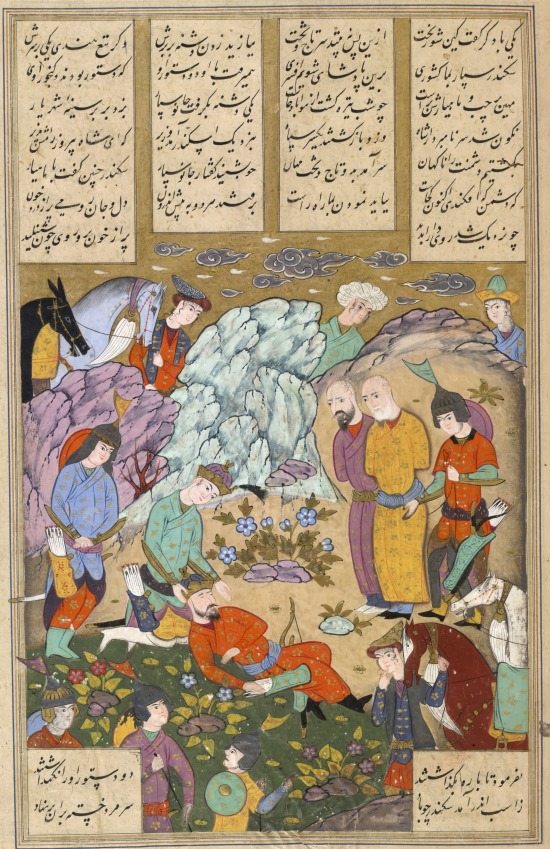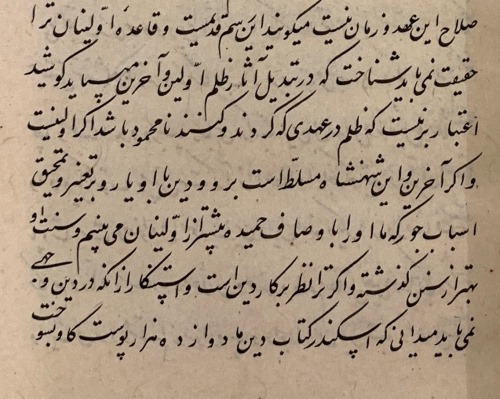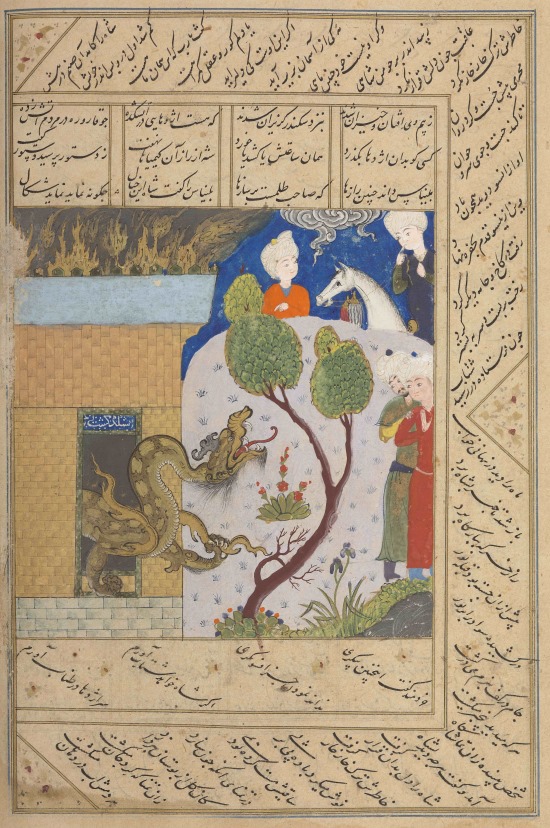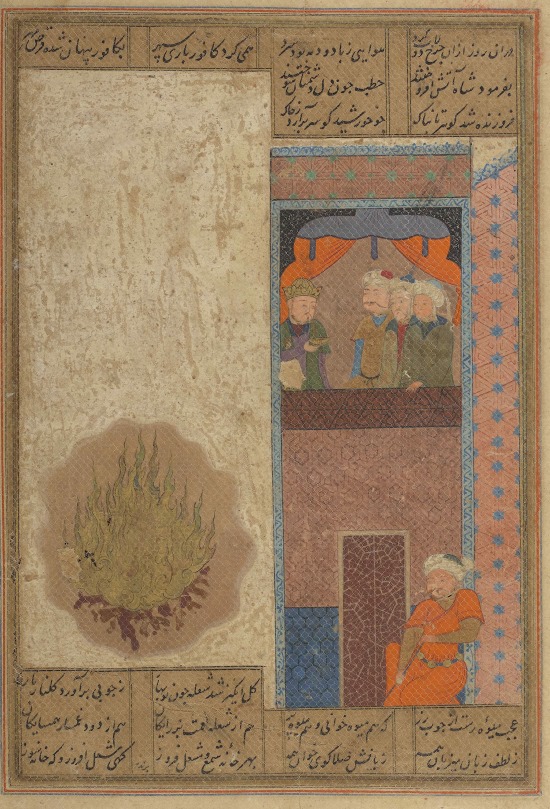In his epic the Shahnamah (Book of Kings), the poet Firdawsi (940–1019 or 1025) vividly describes how Alexander (Iskandar/Sikandar) came upon the Persian emperor Darius (Dara) as he fled north after the battle of Gaugamela in 331 BC. Cradling the mortally wounded Dara on his knees, Iskandar promised “Your word is my command, I’ll promise you whatever you want.” (Shahnamah, Dara 9.42). The dying king’s last wishes were for Iskandar to look after his children, his family and to marry his daughter Roshanak, that their son should safeguard the Zoroastrian religion and live by the Zoroastrian scriptures, the Zend-Avesta, while keeping the traditional feasts of Sadeh and Noruz and preserving the Zoroastrian fire-temples.
Article by Ursula Sims-Williams | British Library

Iskandar comforts the dying Dara. From Firdawsi’s Shahnamah. Iran, 1604 (IO Islamic 966, f. 335r)![]()
Although Alexander readily kept the first two promises, his need to consolidate power within Iran soon put an end to any good intentions he might have held with regard to the Zoroastrian religion. One of his first actions after ascending the throne was to destroy the fire-temples, thus attempting to eliminate all Zoroastrian opposition. In the few examples of Middle Persian literature which survive today, Alexander is demonised and referred to as gizistag ‘accursed.’
Among the most important of the Zoroastrian Middle Persian texts is the Bundahishn (Creation) which describes Alexander’s conquest in these terms:
He killed king Dārāy, destroyed all the family of the lords and the magi and the notables of Iran. He extinguished many fires. He took the religion of the Mazdaean dēn [religion] and the Zand [religious commentaries] and sent them to Rome and burned the Avesta and divided Iran among ninety provincial lords. (Bundahishn 33.19, tr. Thrope & Agostini, p. 173)
This account, written during the early Islamic period, reflects ninth-century traditions which were to some extent already anachronistic. In fact the Zoroastrian scriptures, the Avesta, were transmitted orally and were not written down before the fifth century AD at the earliest.

“Know that Iskandar burned our religious books written on 12,000 oxhides.” From the Letter of Tansar, in Ibn Isfandiyar’s History of Tabaristan. Iran, 1656 (Add MS 7633, f. 10r)
Middle Persian accounts survive to some extent in the early Arabic and Persian histories and in translations and retranslations. One example is the thirteenth-century historian Ibn Isfandiyar’s Tarikh-i Tabaristan (History of Tabaristan) which preserves a translation of the Middle Persian Letter of Tansar, written in the sixth century but now lost in its original form. Allegedly written by Tansar, the Zoroastrian chief priest of Ardashir I (r.224–241), the hostile and negative view of Alexander is in fact an example of Sasanian propaganda dating from the sixth century, several centuries later. Although reported second or third-hand, it is nevertheless important as representing a specifically Zoroastrian point of view and one which was repeated by the early Islamic historians.
Although Alexander was reinvented in the Persian tradition as the rightful heir to the Achaemenid empire, the Zoroastrian perception of him remained hostile. Even in Firdawsi’s Shahnamah he is described by Ardashir, founder of the Sasanian dynasty (224–651) as “the evil-minded (badgumān) tyrant who killed our ancestors one by one” (Shahnamah, Ashkaniyan 10.15).
In later literature however, Alexander was more generally regarded as an Islamic hero. This was largely due to his identification with Dhu’l-Qarnayn (‘two-horned’) whose story is told in Surah 18 of the Qurʼan.[1]

The sorceress Azar Humayun, transformed into a dragon, defends her fire temple. From Nizami’s Sharafnamah (Book of Honour). Iran, 16th century (IO Islamic 387, f. 337v)
In the twelfth-century poet Nizami’s Sharafnamah, the first book of his two-part Iskandarnamah (History of Alexander), Zoroastrianism is linked closely to treasure, magic and young maidens celebrating immodestly at the fire-temple. The bare facts are given: Iskandar ordered the fire-temples and the Zoroastrian books to be destroyed, but the story Nizami uses to illustrate them tells of a beautiful sorceress, Azar Humayun, who turned herself into a dragon to defend her temple. She was eventually defeated by the magic of Iskandar’s philosopher, the magician Balinas (Apollonius), and was restored to her original form. As a nod to propriety her life was spared and she was respectably married off to Balinas as a reward.
Alexander’s role as an Islamic hero was continued in later works such as the Aʼinah-ʼi Iskandari (Iskandar’s Mirror) by Amir Khusraw Dihlavi (1253–1325) and the Khiradnamah-ʼi Iskandari (Iskandar’s Wisdom) by ʻAbd al-Rahman Jami (1414–1492). In them the destruction of Zoroastrianism and the fire-temples is not denied but reinterpreted positively as a pious act to promote Islam.

Alexander discusses the merits of fire and fire-worship with his wise men and resolves to destroy the fire-temples. From Amir Khusraw’s A’inah-ʼi Iskandari. Iran, 1497–98 (Or.11327, f. 174v)
See these items on display in the British Library exhibition Alexander the Great: The Making of a Myth, open until 19 February 2023. Visit our dedicated website to find out more.
We are indebted to the Kusuma Trust, the Patricia G. and Jonathan S. England – British Library Innovation Fund and Ubisoft for their support towards the exhibition, as well as other trusts and private donors.
Ursula Sims-Williams, Lead Curator Persian, British Library
Further reading
Josef Wiesehofer, “The ‘Accursed’ and the ‘Adventurer’: Alexander the Great in Iranian tradition.” In David Zuwiyya (ed), A Companion to Alexander Literature in the Middle Ages. Leiden: Brill, 2011, pp. 113-32.
Haila Manteghi, Alexander the Great in the Persian Tradition: History, Myth and Legend in Medieval Iran. London: I.B. Tauris, 2018.
—————-
[1] See Kevin van Bladel, ‘The Alexander Legend in the Qur’an 18:83-102’. In Reynolds, Gabriel Said (ed.), The Quran in its Historical Context. London: Routledge, 2008, pp. 191-219.
